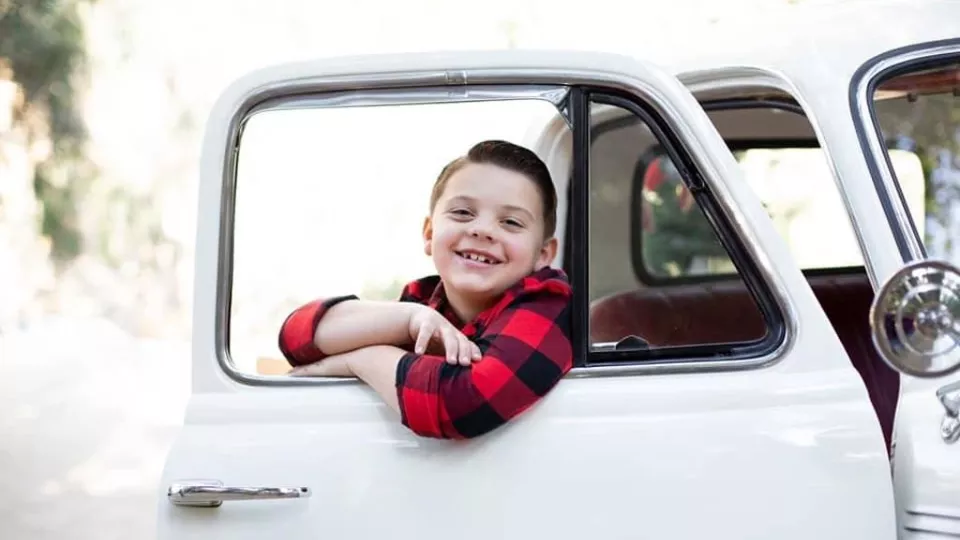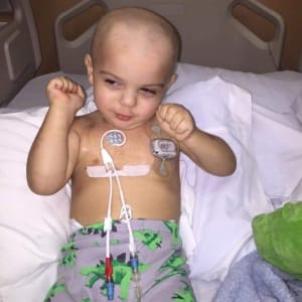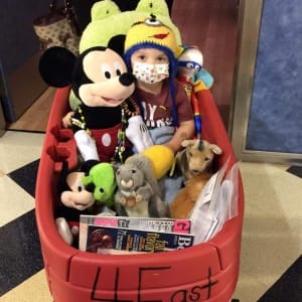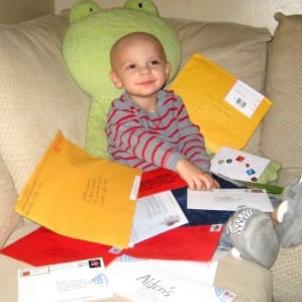
5 Years All-clear!
This is an update from Spring 2021 on Aiden's journey. Scroll down for his original story from 2016.
Aiden is five years all-clear! This means that no sign of leukemia has been detected in more than five years.

“The five-year mark was something we never thought we were going to hit when they originally explained the treatment to us,” says his mom, Ashley. Acute myeloid leukemia (AML) is so serious that his family feared Aiden wouldn’t make it through even one round of chemotherapy. But now, his future is bright. “He has been an absolute rock star,” says Ashley.
Now in second grade, Aiden has earned a place on the honor roll every trimester at his school in Arcadia, California. Aiden loves baseball, camping, the beach, and anything to do with sports. He also just got his first gas-powered dirt bike.
“Life has been nice and full,” says Ashley.
At five years clear, Aiden no longer needs annual oncology visits, although he will continue to be seen by CHLA’s LIFE Cancer Survivorship and Transition Service once a year. And until he’s about 25 years old, he will be followed by the National Institutes of Health as part of a Children’s Oncology Group study he participated in during his care.
“Being five years off chemotherapy and free of cancer is a major milestone for Aiden,” says Diana Moke, MD, the CHLA oncologist who has been involved throughout Aiden’s treatment. “It marks a long and durable remission, and we expect him to live out a full and healthy life.”
Aiden’s Family Fights Leukemia and Finds Answers, Care and Hope
Published on November 29, 2016
Categories: Patient Stories
The signs were subtle. A less persistent person might have listened to the advice from the first few doctors, and just chalked it up to a sinus infection and the overactive imagination of a new mom. But Ashley felt in her gut that it was something more.

They visited their pediatrician. He was admitted to a hospital. They visited an ophthalmologist. They visited an orthopaedist. No one could give them answers that made sense.
Why had 2-year-old Aiden broken so many bones in such a short time period? Why did he complain of “owies” in his legs and arms? Why did he wake up one morning unable to speak well? And what was that mass inside his orbital socket that showed up on an MRI?
Don’t worry?
“OK.” (Said no mom, ever.)
Many of these specialists had mentioned Children’s Hospital Los Angeles, but when Ashley and her husband, Kenneth, looked at all of the information together with their pediatrician, the doctor became very alarmed and sent them to CHLA right away.
“You need to go right now … take them this note,” Ashley recalls the doctor saying. She told him they’d go home and pack a bag and head to CHLA. “I didn’t say go home,” he answered. “I said go now.”
‘They gave us hope’
Even the staff at CHLA were initially stumped about Aiden’s condition, but not for long. After they ran a battery of tests, they sent the family home, but checked in daily about the status of his test results, which were being shared across the country. Eventually sending samples all the way to the National Institutes of Health, they finally made a diagnosis—acute myeloid leukemia (AML).

When someone presents with a mass or swelling like that, it’s much more common to find a solid tumor. Leukemia is not the first thing doctors think of.
Though the news wasn’t good, at least it was a tangible foe they could begin to fight.
“It may not have been the answers we wanted,” says Ashley, “but they gave us the answers we needed, and they gave us hope. They gave us a plan.”
The next day Aiden was fitted with a central catheter, and he was started on chemotherapy right away. Often after the first round of treatment, any sign of progress is good news. For Aiden, they got the best news.
“We checked the bone marrow to see if there were any more leukemia cells, and after the first round, he didn’t have any,” says Diana Moke, MD, a fellow in the Division of Hematology, Oncology and Blood and Marrow Transplantation at CHLA. Following the treatment protocol for leukemia, all four rounds of chemotherapy were completed, and Aiden has not had any sign of the disease since.
“When you hope for progress and see complete eradication—it is awesome,” says Ashley.
Aiden’s not completely out of the woods, but so far, he’s doing well. He will be closely monitored for the next year, with monthly blood tests and checkups. She notes that his “NMRD” status (negative minimal residual disease) is a good sign.
Stop me if you’ve heard this one
During Aiden’s time in the hospital, his parents found that one of their greatest assets was his favorite Child Life specialist, Erin Shields, CCLS, or “Miss Erin” as they call her, and the rest of the Child Life team.
“They have been crucial, especially to my husband and I, trying to figure out how to explain this to him,” says Ashley. “How do you tell a 2-year-old that he has cancer? You can barely comprehend it, let alone trying to break it down for them.” The Child Life specialists were there every step of the way, helping with IV placements, blood draws, dressing changes, scans and more, and helping make the hospital a little less scary for a kid (and his parents).
“I think a lot of the time, people are hesitant [to share difficult information] with younger kids,” says Shields. “But Aiden sought that information. ‘What’s going on? Why am I here? Why can’t I go home?’” With her help, his parents explained to him that his blood was sick, and that he had to come to the hospital to get special medicine. At 2 years old, that was just the explanation he needed.

Aiden and Shields also share a love of corny jokes.
“‘Let me tell you a joke,’” she remembers him saying. “‘Why did the banana go to the hospital? Because it wasn’t peeling well!’” She also taught him to sell the joke by laughing loudly right after the punch line. Aiden was a quick learner, and his jokes became his trademark.
His doctor remembers another one. “‘How do you make a tissue dance?’” recalls Moke. “‘You put a little boogie in it.’ And then he did a little dance.”
Worldwide support
Aiden received some special attention on his birthday, Valentine’s Day, in 2016. With a hospital room well-stocked with toys, he didn’t want more presents. What he wanted was cards. The request caught the attention of the media, and Aiden ended up receiving more than 10,000 cards from all over the world.
His parents couldn’t be more thankful that they found Children’s Hospital Los Angeles.
“When you’re in desperate need of answers and you don’t know where to turn, if so many different doctors point you here to this hospital, there’s a reason,” says Ashley. “We couldn’t find answers at other hospitals, with other doctors. We came here, and they gave us the answers that we needed.”


